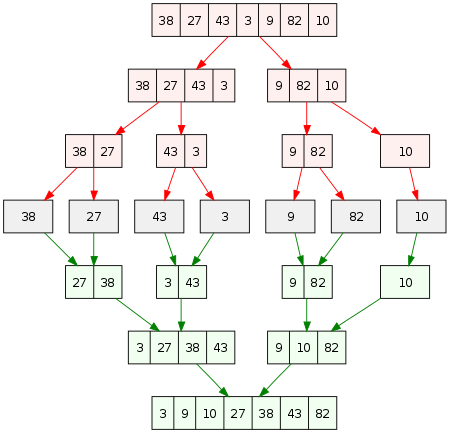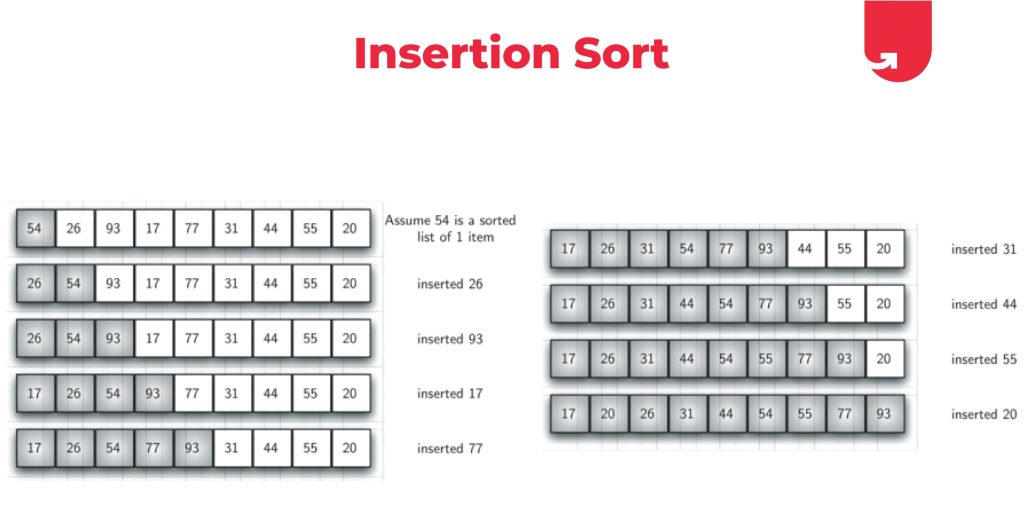The arrangement of data in a preferred order is called sorting in the data structure. By sorting data, it is easier to search through it quickly and easily. The simplest example of sorting is a dictionary. Before the era of the Internet, when you wanted to look up a word in a dictionary, you would do so in alphabetical order. This made it easy.
Imagine the panic if you had to go through a big book with all the English words from the world in a jumbled order! It is the same panic an engineer will go through if their data is not sorted and structured.
So, in short, sorting makes our lives easier. Check out our data science courses to learn in-depth about data science algorithms.
In this post, we will take you through the different data structures & sorting algorithms. But first, let’s understand what a sorting algorithm is and sorting in data structure.
What is a Sorting Algorithm?
A sorting algorithm is just a series of orders or instructions. In this, an array is an input, on which the sorting algorithm performs operations to give out a sorted array.
Many children would have learned to sort in data structures in their computer science classes. It is introduced at an early stage to help interested children get an idea of deeper computer science topics – divide-and-conquer methods, binary trees, heaps, etc.
Here’s an example of what sorting does.
Let’s suppose you have an array of strings: [h,j,k,i,n,m,o,l]
Now, sorting would yield an output array in alphabetical order.
Output: [h,i,j,k,l,m,n,o]
Let’s learn more about sorting in data structure.
Checkout: Types of Binary Tree
Importance Of Sorting In Data Structure
Before delving into the different types of sorting in data structure, let’s first look at why sorting in data structure is important. Sorting in DSA actually provides users with several benefits. For example, when you are performing sorting on elements, many complications such as min/max, kth smallest/largest get automatically simplified. Furthermore, sorting also provides you with many algorithmic solutions, some of which might include divide and conquer, iterative, and recursive-based.
Last but not least, perhaps one of the biggest benefits of sorting in DSA is time complexity. As a coder, the ultimate goal is to solve any kind of complex problem within the minimum amount of time. That is where different types of sorting in data structure come into play. It not only saves up your very precious time but also provides you with the right solution.
With that said, now lets’ take a look at the different sorting techniques in data structure.
Sorting Categories
There are two different categories in sorting:
- Internal sorting: If the input data is such that it can be adjusted in the main memory at once, it is called internal sorting.
- External sorting: If the input data is such that it cannot be adjusted in the memory entirely at once, it needs to be stored in a hard disk, floppy disk, or any other storage device. This is called external sorting.
Read: Interesting Data Structure Project Ideas and Topics
Types of Sorting in Data Structure
Here are a few of the most common types of sorting algorithms.

1. Merge Sort
This algorithm works on splitting an array into two halves of comparable sizes. Each half is then sorted and merged back together by using the merge () function.
Our learners also read: Free Data structures and Algorithms course!
Here’s how the algorithm works:
MergeSort(arr[], l, r)
If r > l
- Divide the array into two equal halves by locating the middle point:
middle m = (l+r)/2
- Use the mergeSort function to call for the first half:
Call mergeSort(arr, l, m)
- Call mergeSort for the second half:
Call mergeSort(arr, m+1, r)
- Use the merge () function to merge the two halves sorted in step 2 and 3:
Call merge(arr, l, m, r)
Our learners also read: Free excel courses!
Check out the image below to get a clear picture of how this works.

Python program for merge sort implementation
def mergeSort(a):
if len(a) >1:
mid = len(a)//2
A = a[:mid]
B = a[mid:]
mergeSort(A)
mergeSort(B)
i = j = k = 0
while i < len(A) and j < len(B):
if A[i] < B[j]:
a[k] = A[i]
i+=1
else:
a[k] = B[j]
j+=1
k+=1
while i < len(A):
a[k] = A[i]
i+=1
k+=1
while j < len(R):
a[k] = B[j]
j+=1
k+=1
def printList(a):
for i in range(len(a)):
print(a[i],end=” “)
print()
if __name__ == ‘__main__’:
a = [12, 11, 13, 5, 6, 7]
mergeSort(a)
print(“Sorted array is: “, end=”\n”)
printList(a)
Learn more: Recursion in Data Structure: How Does it Work, Types & When Used
Explore our Popular Data Science Courses
2. Selection Sort
In this, at first, the smallest element is sent to the first position.

Then, the next smallest element is searched in the remaining array and is placed at the second position. This goes on until the algorithm reaches the final element and places it in the right position.
Look at the picture below to understand it better.
Python program for selection sort implementation
import sys
X = [6, 25, 10, 28, 11]
for i in range(len(X)):
min_idx = i
for j in range(i+1, len(X)):
if X[min_idx] > X[j]:
min_idx = j
X[i], X[min_idx] = X[min_idx], X[i]
print (“The sorted array is”)
for i in range(len(X)):
print(“%d” %X[i]),
Data Science Advanced Certification, 250+ Hiring Partners, 300+ Hours of Learning, 0% EMI
Our learners also read: Free Python Course with Certification
Top Data Science Skills to Learn
| Top Data Science Skills to Learn | ||
| 1 | Data Analysis Course | Inferential Statistics Courses |
| 2 | Hypothesis Testing Programs | Logistic Regression Courses |
| 3 | Linear Regression Courses | Linear Algebra for Analysis |
upGrad’s Exclusive Data Science Webinar for you –
Transformation & Opportunities in Analytics & Insights
3. Bubble Sort
It is the easiest and simplest of all the sorting algorithms. It works on the principle of repeatedly swapping adjacent elements in case they are not in the right order.

In simpler terms, if the input is to be sorted in ascending order, the bubble sort will first compare the first two elements in the array. In case the second one is smaller than the first, it will swap the two, and move on to the next element, and so on.
Example:
Input: 637124
First pass
637124 -> 367124 : Bubble sort compares 6 and 3 and swaps them because 3<6.
367124 -> 367124 : Since 6<7, no swapping
367124 -> 361724 : Swapped 7and 1, as 7>1
361724 -> 361274 : Swapped 2 and 7, as 2<7
361274 -> 361247 : Swapped 4 and 7, as 4<7
Second pass
361247 -> 361247
361274 -> 316274
316274 -> 312674
312674 -> 312674
312674 -> 312647
Third pass
312647 -> 132647
132647 -> 123647
123647 -> 123647
123647 -> 123467
123467 -> 123467
As you can see, we get the ascending order result after three passes.
Python program for bubble sort implementation
def bubbleSort(a):
n = len(a)
for i in range(n):
for j in range(0, n-i-1):
if a[j] > a[j+1] :
a[j], a[j+1] = a[j+1], a[j]
a = [64, 34, 25, 12, 22, 11, 90]
bubbleSort(a)
print (“The sorted array is:”)
for i in range(len(a)):
print (“%d” %a[i]),
Also read: Data Frames in Python: Python In-depth Tutorial
Read our popular Data Science Articles
4. Insertion Sort-

Insertion sort falls under one of the most popular sorting types in data structure. It is basically an algorithm that helps to place an unsorted element at its suitable position in each iteration. It’s similar to the way you sort your cards during a card game. The first card is usually considered to be already sorted, and the next card that you pick up is then compared against the first one. Based on the first card, you wither place the unsorted second card on the right or left side of the former one. The insertion sort follows the same approach.
5. Quick Sort-
Also known as partition exchange sorting, quick sort is yet another very popular sorting types in data structure that is based on partition. Using this particular algorithm, you pick on an element, which is known as the pivot element, and then rearrange the rest of the elements around the pivot element. It then further divides the array into two specific sub-arrays. Once you have fixed the pivot element, then it automatically disintegrates the rest of the elements. For example, elements that are lesser are placed on the left side of the pivot element, and elements on the right side are usually the ones that are greater. This whole process continues until only one element is left in the sub-array.
With this, we come to an end of the different types of sorting techniques in data structure. As quite visible from the list, each DSL sorting has its own advantages and disadvantages. Therefore, while choosing the most efficient one, you need to first understand the need for your data. For example, if you are looking for something stable, you should go with the merge. Simultaneously, if you are constrained in space, heap sort is the perfect choice for you.
How to Choose the Right Sorting Algorithm?
Sorting algorithms play an essential role in organizing data efficiently, but selecting the right one depends on various factors. Here, we’ll explore key considerations to help you make an informed decision wholly based on your needs.
-
Size of the Data Set
When dealing with data, size matters. For smaller datasets, the choice of sorting algorithm may not be a critical concern, as most algorithms perform reasonably well with limited data. However, as your dataset grows in size, the selection becomes crucial. In such cases, prioritizing algorithms that are fast and efficient in managing memory becomes imperative.
Consider options like merge sort or heap sort for large datasets, as they demonstrate better scalability and memory usage than simpler algorithms like bubble sort or insertion sort.
-
Type of Data
Understanding the nature of your data is pivotal in choosing the most effective sorting algorithm. Different algorithms exhibit varying performance depending on the data type. For numeric data, quicksort often outshines mergesort in terms of speed, while the scenario might be different for strings.
For instance, if your dataset primarily consists of strings, you might want to explore sorting algorithms specifically designed for string comparisons, such as radix sort. Tailoring your choice based on the data type ensures optimal efficiency.
-
Structure of the Data
The existing structure of your data can significantly impact sorting performance. If your data is already partially sorted, leveraging algorithms that capitalize on this characteristic is prudent. Insertion sort, for example, excels in scenarios where the data is nearly sorted, outperforming more complex algorithms like quicksort.
Before making a decision, assess the degree of pre-sortedness in your dataset and choose an algorithm that aligns with its inherent structure for optimal results.
-
Your Specific Needs
Consider your unique requirements when selecting a sorting algorithm. Some situations demand stability, ensuring that the order of equal elements remains unchanged. In contrast, others may allow modifications to the input array during the sorting process.
Factor in these considerations based on the context of your application. If stability is crucial, algorithms like merge or bubble sort may be more suitable. At the same time, situations permitting array modifications may open doors to more aggressive and efficient options like quicksort.
What are the Challenges Faced in sorting program in data structure?
| Challenge | Description |
| Time Complexity | Sorting algorithms grapple with time complexity, contingent on the dataset’s size and organization. The larger the dataset, the more time it may take for sorting algorithms to complete their task, posing challenges, especially with substantial datasets. |
| Memory Complexity | Memory usage becomes critical as sorting algorithms may demand significant memory resources. The challenge intensifies with larger datasets, where the memory required for sorting might surpass the available resources, leading to potential bottlenecks. |
| Computational Complexity | Certain sorting algorithms exhibit intricate computational complexities, rendering them challenging to comprehend, implement, and debug. The complexity of these algorithms can hinder seamless integration into applications and necessitate careful consideration during selection. |
| Data Representation | Efficient sorting hinges on the apt representation of the data being sorted. Different types of data may necessitate diverse sorting algorithms to ensure efficiency. Adapting the sorting approach to the data’s nature is pivotal for achieving optimal performance in the sorting process. |
| Performance | The efficiency of sorting algorithms is contingent on the dataset’s size, with some algorithms outperforming others in specific scenarios. Selecting the appropriate sorting algorithm is paramount to achieving efficient sorting, ensuring optimal performance tailored to the dataset’s characteristics. |
What are the Applications of Sorting in Data Structure?
Sorting within data structures is a cornerstone in diverse domains, pivotal in optimizing data organization and elevating algorithmic efficiency. Let’s explore some key applications where sorting proves to be indispensable.
-
Databases: Enhancing Search Operations
In databases, sorting emerges as a linchpin for optimizing search operations. The creation of indexes utilizing sorted keys is a common practice. This strategic utilization of sorting facilitates rapid data retrieval and expedites query processing. Maintaining an organized structure, databases streamline access to specific information, enhancing overall system performance.
-
Search Algorithms: Boosting Efficiency in Retrieval
Sorting takes center stage in many search algorithms, with notable examples like binary search relying on the efficiency of sorted data. Sorting significantly reduces the time required to pinpoint specific elements within vast datasets. As a result, search algorithms operating on sorted data contribute to quicker and more resource-efficient information retrieval.
-
Information Retrieval: Accelerating Search Engines and Systems
In search engines and information retrieval systems, sorting emerges as a catalyst for accelerated performance. By leveraging sorting, these systems swiftly retrieve relevant documents, websites, or information based on user queries. The organized structure facilitated by sorting ensures that pertinent results are efficiently surfaced, enhancing user experience and system responsiveness.
-
Data Analysis: Unveiling Insights and Patterns
Sorting plays a pivotal role in data analysis, acting as a catalyst for identifying patterns, trends, and outliers within datasets. In fields such as statistical analysis and financial modeling, where data-driven insights are paramount, sorting becomes crucial. The organized arrangement of data simplifies extracting meaningful information, contributing to more informed decision-making.
What is the Scope of Sorting Technique in Data Structure?
Types of sorting in data structure techniques are integral to algorithms, offering efficient data storage and retrieval solutions. The choice of sorting method depends on factors such as dataset size and the nature of the data being organized. Each technique like big data pipeline tools, big data practice projects, and big data project architecture carries distinct advantages and drawbacks, emphasizing the importance of choosing the perfect approach for a given task.
| Sorting Technique | Scope |
| Quick Sort | external sorting in data structure is ideal for efficiently sorting large datasets, employing a divide-and-conquer strategy for swift results. |
| Bubble Sort | While simple to comprehend and implement, it is better suited for smaller datasets due to its inefficiency with larger ones. |
| Merge Sort | Embraces a divide-and-conquer approach, proving efficient for larger datasets where scalability is paramount. |
| Insertion Sort | Apt for small datasets, functioning by inserting each element into its correct position with a straightforward implementation. |
| Selection Sort | Well-suited for larger datasets, it selects and places the smallest or largest element at the array’s beginning. |
| Heap Sort | Leverages the heap data structure, demonstrating efficiency with large datasets through a systematic sorting process. |
| Radix Sort | Grouping elements into buckets based on numerical value excels in efficiently sorting large datasets. |
| Bucket Sort | Dividing elements into buckets and sorting each bucket is effective for efficiently handling large datasets. |
Conclusion
That wraps up sorting in data structure and the most common sorting algorithms. You can choose any of the different types of sorting algorithms. However, remember that some of these can be a little tedious to write the program for. But then, they might come in handy for quick results. On the other hand, if you want to sort large datasets, you must choose the bubble sort. Not only does it yield accurate results, but is also easy to implement. Then again, it is slower than the other types. I hope you liked the article about sorting in data structure.
To gain more insights into how sorting works, reach out to us and we will help you get started on the course that best suits your needs!
If you are curious to learn about data science, check out IIIT-B & upGrad’s Executive PG Program in Data Science which is created for working professionals and offers 10+ case studies & projects, practical hands-on workshops, mentorship with industry experts, 1-on-1 with industry mentors, 400+ hours of learning and job assistance with top firms.
Have fun coding!

![Sorting in Data Structure: Categories & Types [With Examples]](/__khugblog-next/image/?url=https%3A%2F%2Fd14b9ctw0m6fid.cloudfront.net%2Fugblog%2Fwp-content%2Fuploads%2F2020%2F05%2F493-Sorting-in-Data-Structure.png&w=1920&q=75)




















![Top 13 Highest Paying Data Science Jobs in India [A Complete Report]](/__khugblog-next/image/?url=https%3A%2F%2Fd14b9ctw0m6fid.cloudfront.net%2Fugblog%2Fwp-content%2Fuploads%2F2020%2F08%2F904-scaled.jpg&w=3840&q=75)
![Most Common PySpark Interview Questions & Answers [For Freshers & Experienced]](/__khugblog-next/image/?url=https%3A%2F%2Fd14b9ctw0m6fid.cloudfront.net%2Fugblog%2Fwp-content%2Fuploads%2F2020%2F09%2F991.png&w=3840&q=75)



![Inheritance in Python | Python Inheritance [With Example]](/__khugblog-next/image/?url=https%3A%2F%2Fd14b9ctw0m6fid.cloudfront.net%2Fugblog%2Fwp-content%2Fuploads%2F2020%2F12%2F1434.png&w=3840&q=75)


